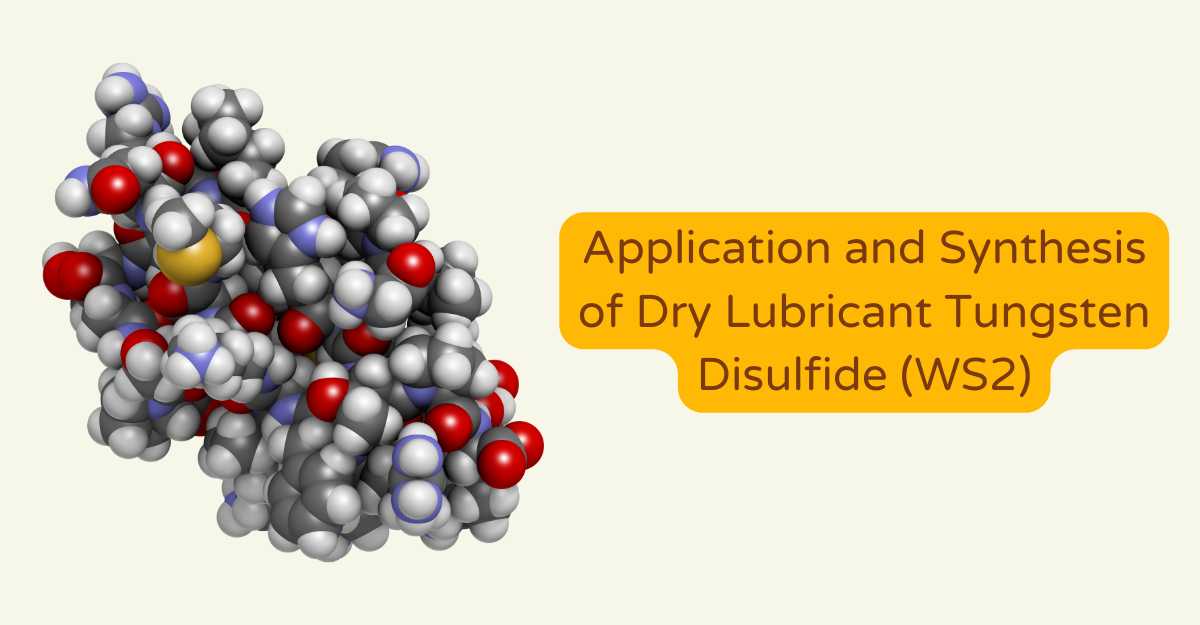
Application and Synthesis of Dry Lubricant Tungsten Disulfide (WS2)
Friction is caused by the movement of one surface over another surface which it is in contact with. The friction force always acts in an opposite direction than that of relative displacement between the two surfaces. It is the main cause of wear and energy dissipation.
To reduce the friction between the two moving surfaces lubricants are used. There are different types of lubricants: semi-solid, dry/solid, liquid or gaseous. Tungsten Disulfide (WS2) is a dry/solid lubricant and the most lubricious substance known. It has an anisotropic layered structure of the form S-W-S. The two hexagonal planes of the S atoms are separated by a plane of W atoms.
Strong covalent bonds exist within the lamella while the lamellas are bonded by weak Van der Waal forces. This allows easy shear of layers in the structure which leads to low frictional properties. It can offer excellent lubrication under extreme temperature, load and vacuum conditions.
WS2 has properties like high resistance to oxidation at high temperatures, good thermal stability and reduced coefficient of friction at higher loads. The reactivity of WS2 is preventable and low. When tungsten disulfide powder is added to liquid lubricants, it allows the particles to penetrate uneven areas and fill the gap between them. It will form a film layer that can take high pressure.
The size of the particles should be smaller so that they can penetrate or similar in size to the hardness of the material to fill the pores efficiently. The presence of WS2 particles in the lubricant allows the lubrication to be more efficient than when compared to conventional lubricants. The particles protect the components against wear and tear.
Applications of WS2
- WS2 is mostly used as a dry lubricant as an additive in composites to increase the self-lubricating properties. It is widely used in the aerospace industry where liquid lubricants cannot be used.
- In powder form, WS2 can be added to motor oil to enhance the friction properties of the medium.
- It is used as a dry lubricant for bearings, mould release and fasteners. It is used in stainless steel fastening and military applications. It is used as a sole lubricant in precision bearings and gears in a vacuum.
- It is used in application for hygienic reasons where oils and grease cannot be used. The solid lubricant WS2 helps to maintain the safe and reliable operation of the machine.
- It is used in metal processing where high temperatures are required.
Synthesis of WS2
The synthesis processes are divided into three categories: Physical, Chemical and Stripping.
Physical process
The two main processes used are magnetron sputtering and pulsed laser deposition. In the magnetron sputtering method, a solid material is bombarded to cause the object to sputter under vacuum conditions. In sputtering the particles of the materials are ejected due to the bombardment of high-energy particles. The ejected particles are aimed at the substrate to allow the growth of this film. The sputtering target is the cathode made of WS2. This process can yield a large and dense coating area with good adherence.
The pulsed laser deposition process is complex and more costly. However, it can maintain high quality and control the thickness of the film.
Chemical process
The two main processes are chemical vapour deposition (CVD) and the growth of WS2 crystals with the hydrothermal method. In the CVD you can follow a one-step or two-step method. In the one-step method tungsten and sulphur are directly heated which is transferred to the substrate using a carrier gas.
In the two-step method, the substrate is covered with tungsten or tungsten compound. The substrate is then vulcanised in a CVD furnace to form the WS2 film. The thickness of the film can be controlled by the initial tungsten coating.
The hydrothermal method is also called the wet chemical synthesis. This process helps to produce WS2 particles of high quality and crystallinity. However, the thickness of the film cannot be controlled.
Stripping process
In this process, a thin layer or film from the bulk material is moved to another surface. The widest methods used for this are mechanical exfoliation and liquid exfoliation. In the mechanical exfoliation process, a piece of tape with good adhesive is used. The tape is repeatedly pressed onto the surface of the bulk material and stripped. It is then transferred from the tape to another material.
In the liquid exfoliation method, ultrasonic waves are used to loosen and separate the layered WS2 through shear force and cultivation bubbles. Once the layers are separated the material is dispersed in the solvent.






